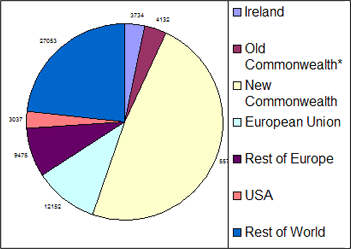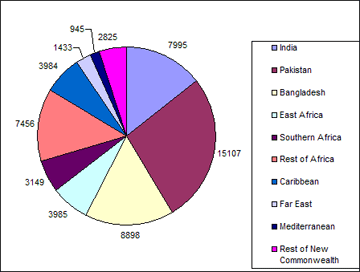The social impact of immigration
1 March, 2005
1. Figures released by the Office of National Statistics (ONS) on 16th December [1] show that of the 621,000 births in the United Kingdom in 2003, 115,000 (18.6%) were to mothers who were born outside the UK.
2. By comparison there were 81,000 births to foreign-born mothers in 1993 and these made up just 12.1% of the total births in that year.
3. These numbers reflect the high levels of foreign immigration in recent years. In the 10 years from 1993 to 2002 inclusive there was a net inflow of about 1.65 million foreign-born people to the UK and a net outflow of over 600,000 UK-born people [2] .
4. The majority of the resulting net increase in population through migration is in the younger age groups. In 2002, for instance, over 60% of the net addition to population through migration occurred in the 15 to 24 age group and the 25 to 44 age group accounted for most of the remainder [3].
5. The high-levels of migration, and the young age profile of immigrants, are the main factors behind population growth in the UK. The latest release of 'Population Trends' from the ONS confirms that, on the principal projection of 130,000 net migration a year, the population will rise by 6.1 million by 2031. Of this 6.1 million, nearly 5.2 million (84%) will be attributable to net migration - 3.6 million migrants and a further 1.5 million due to an excess of births over deaths from this migrant population.
6. Of the 115,000 births to foreign-born mothers, the origins of the mother were as follows:

* Australia, New Zealand and Canada
7. Of the births to mothers from the New Commonwealth, the countries/regions of the mothers' origins were as shown below:

8. In parts of the United Kingdom births to foreign-born mothers now represent more than 50% of all live births. In Inner London as a whole the figure is 55% with Tower Hamlets, Newham and Westminster having the highest percentages at 68%.
9. Outer London also has a high percentage of births to foreign-born mothers at 41% with the highest figure being recorded in Brent at 65%.
10. The percentage for Greater London as a whole is 47%, i.e. nearly one birth in every two in the capital is to a foreign-born mother.
11. Outside London, Manchester, Bradford, Leicester, Birmingham, Cambridge, Forest Heath (Suffolk), Slough and Oxford recorded more than 30% of births to foreign-born mothers.
12. In some cases, such as Westminster and Oxford, the high percentages reflect the international character of the city with no predominant ethnic group. In Westminster for instance the largest ethnic group is African and they make up under 4% of the population. In Oxford no minority ethnic group makes up more than 2% of the population.
13. The very high proportion of births to foreign-born mothers in some English cities together with the outflow of city dwellers to the regions (see Migrationwatch report: "The effect of Immigration on the Regions") explains the very rapid changes taking place in parts of our cities. It again raises the question of how satisfactory integration can be achieved in areas where British culture itself is already diminishing.
14. Immigration at the present pace will considerably exacerbate the problem. As the Government's Cohesion Panel put it in July 2004; "The pace of change (for a variety of reasons) is simply too great in some areas at present".
Footnotes
- ONS Birth Statistics Series FM1 no 32
- Source: ONS: MN29 International Migration - table 2.5
- Ibid table 2.9
- ONS Birth Statistics Series FM1 no 32
- Source: ONS: MN29 International Migration - table 2.5
- Ibid table 2.9
